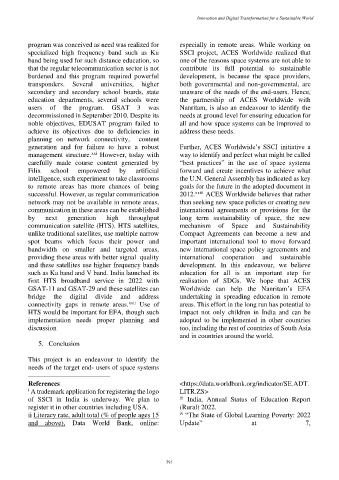Page 435 - Kaleidoscope Academic Conference Proceedings 2024
P. 435
Innovation and Digital Transformation for a Sustainable World
program was conceived as need was realized for especially in remote areas. While working on
specialized high frequency band such as Ku SSCI project, ACES Worldwide realized that
band being used for such distance education, so one of the reasons space systems are not able to
that the regular telecommunication sector is not contribute its full potential to sustainable
burdened and this program required powerful development, is because the space providers,
transponders. Several universities, higher both governmental and non-governmental, are
secondary and secondary school boards, state unaware of the needs of the end-users. Hence,
education departments, several schools were the partnership of ACES Worldwide with
users of the program. GSAT 3 was Nanritam, is also an endeavour to identify the
decommissioned in September 2010. Despite its needs at ground level for ensuring education for
noble objectives, EDUSAT program failed to all and how space systems can be improved to
achieve its objectives due to deficiencies in address these needs.
planning on network connectivity, content
generation and for failure to have a robust Further, ACES Worldwide’s SSCI initiative a
xxi
management structure. However, today with way to identify and perfect what might be called
carefully made course content generated by “best practices” in the use of space systems
Filix school empowered by artificial forward and create incentives to achieve what
intelligence, such experiment to take classrooms the U.N. General Assembly has indicated as key
to remote areas has more chances of being goals for the future in the adopted document in
successful. However, as regular communication 2012. xxiii ACES Worldwide believes that rather
network may not be available in remote areas, than seeking new space policies or creating new
communication in these areas can be established international agreements or provisions for the
by next generation high throughput long term sustainability of space, the new
communication satellite (HTS). HTS satellites, mechanism of Space and Sustainability
unlike traditional satellites, use multiple narrow Compact Agreements can become a new and
spot beams which focus their power and important international tool to move forward
bandwidth on smaller and targeted areas, new international space policy agreements and
providing these areas with better signal quality international cooperation and sustainable
and these satellites use higher frequency bands development. In this endeavour, we believe
such as Ka band and V band. India launched its education for all is an important step for
first HTS broadband service in 2022 with realisation of SDGs. We hope that ACES
GSAT-11 and GSAT-29 and these satellites can Worldwide can help the Nanritam’s EFA
bridge the digital divide and address undertaking in spreading education in remote
connectivity gaps in remote areas. xxii Use of areas. This effort in the long run has potential to
HTS would be important for EFA, though such impact not only children in India and can be
implementation needs proper planning and adopted to be implemented in other countries
discussion too, including the rest of countries of South Asia
and in countries around the world.
5. Conclusion
This project is an endeavour to identify the
needs of the target end- users of space systems
References <https://data.worldbank.org/indicator/SE.ADT.
i A trademark application for registering the logo LITR.ZS>
of SSCI in India is underway. We plan to iii India, Annual Status of Education Report
register it in other countries including USA. (Rural) 2022.
ii Literacy rate, adult total (% of people ages 15 iv “The State of Global Learning Poverty: 2022
and above), Data World Bank, online: Update” at 7,
– 391 –

